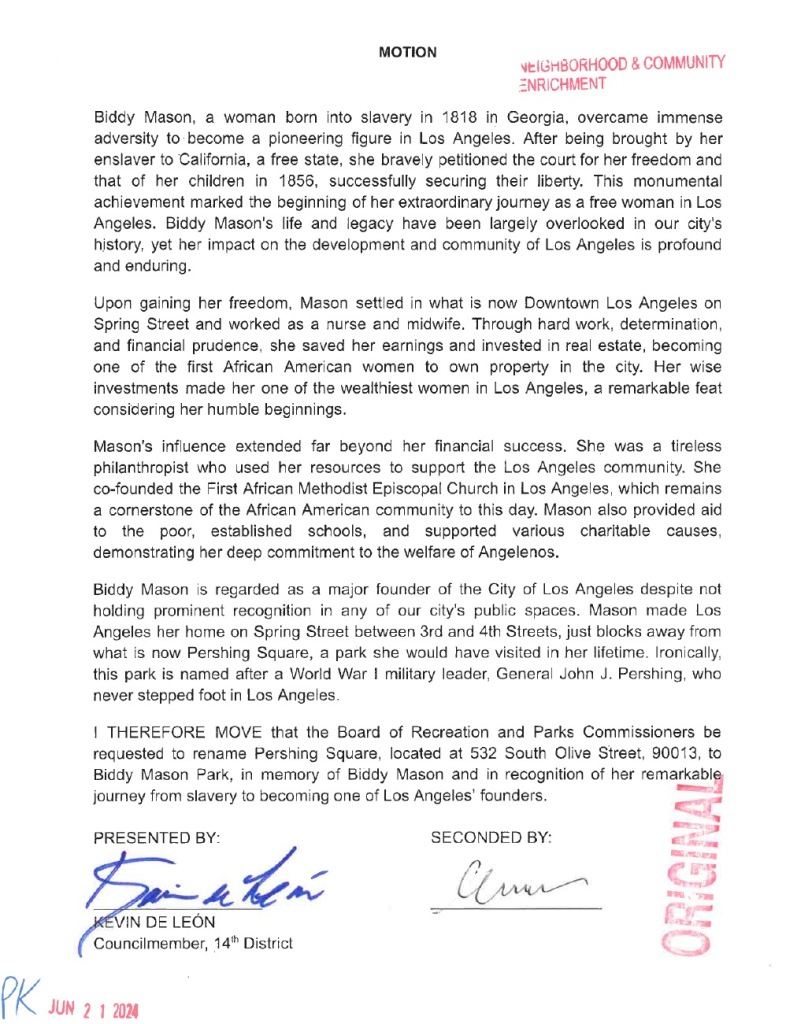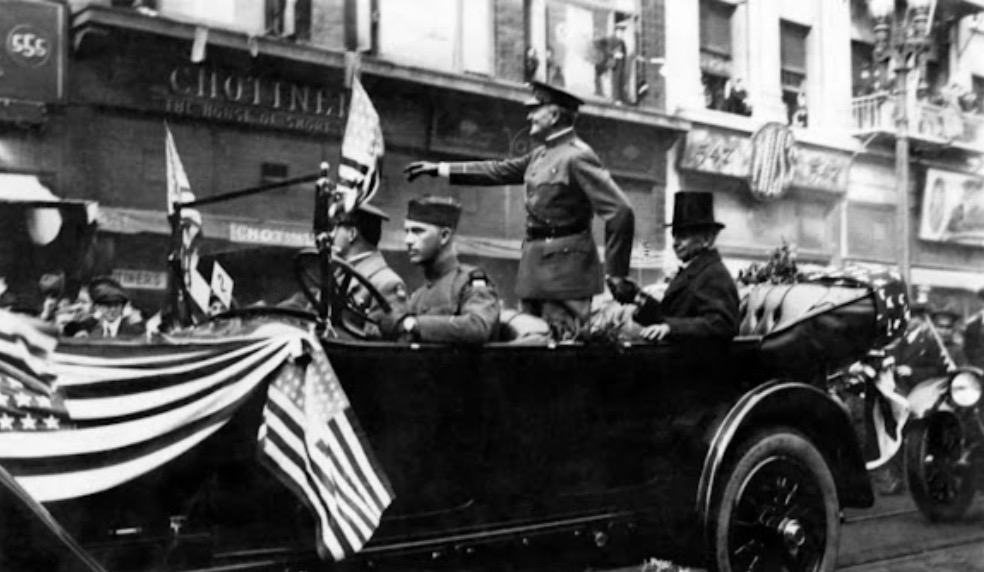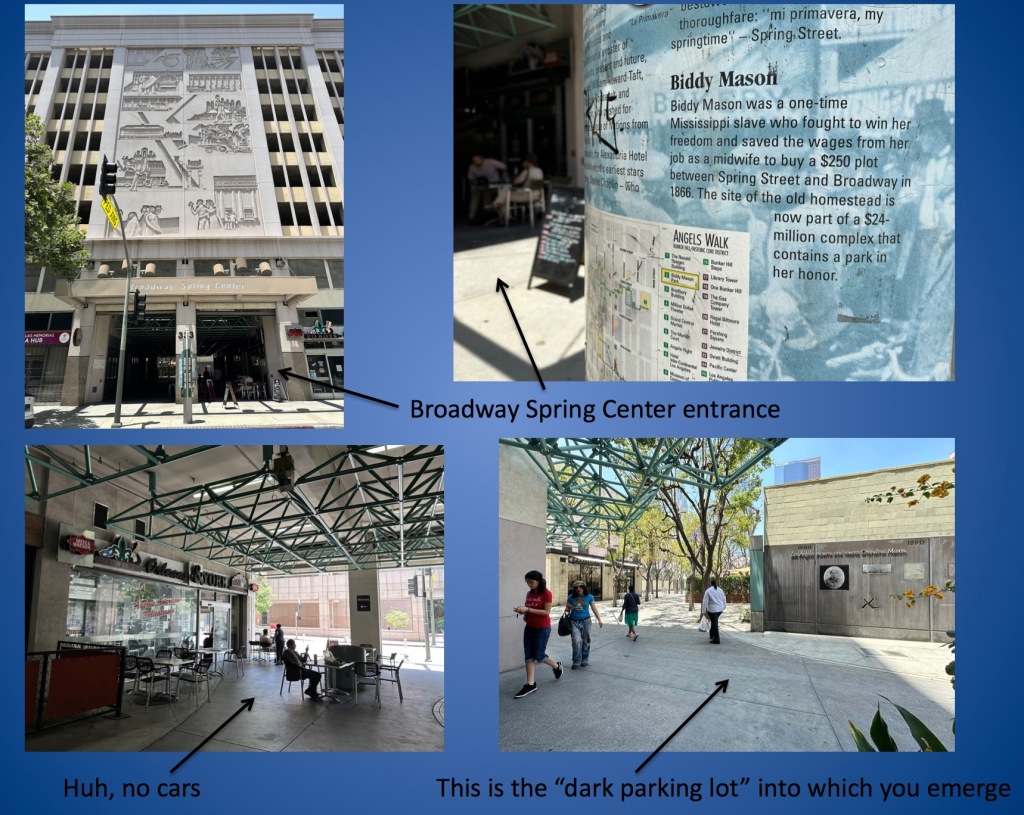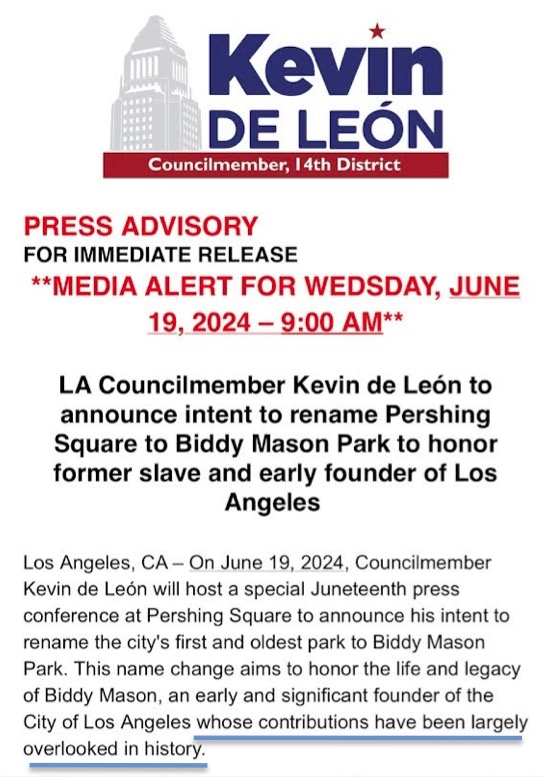Today we talk about Pershing Square. Perhaps it’s not Bunker Hill proper—bordering the Hill’s southern edge—but I consider it an essential part of the Hill story. It is, after all, where so many of the Hill’s elderly residents spent their days (for example, go to 11:11 in the great 1956 documentary about Bunker Hill to witness a Pershing Square chat between an old fellow and William S. Burroughs’ doppelgänger). We’re also going to talk about Biddy Mason, who has a Bunker Hill connection: she owned the land on which African Methodist Episcopal had its church, at Fourth and Charity (now Grand, site of the Wells Fargo tower). She wouldn’t let the parishioners meet there, because the faithful owed her back taxes!
So, I deal today with Pershing Square and Biddy Mason, because there is a motion before Council to rename Pershing Square to Biddy Mason Park.

Biddy Mason is, unquestionably, a fantastic and important part of LA, but the present narrative raises eyebrows. First of all, it comes from Kevin de León. It was de León’s office that pushed through the counterfactual Cooper Donut embarrassment, so, anything from that office involving “history” should be doubly scrutinized.
Right off the bat, in yesterday’s Council motion de León’s sole mention of Pershing is an absolute and ridiculous falsehood, stating “well, maybe Biddy Mason went to the park, but we know for a fact that Pershing certainly never did, because he never visited Los Angeles even once!”—

For the love of God, Kevin de León, if you’re going to LIE ABOUT EVERYTHING, at least do it WELL. Seriously, attempt some semblance of veracity.
For the record: Pershing spent a LOT of time in Los Angeles: during World War One he commanded the headquarters of the Coast Artillery, AND delivered addresses to the Red Cross, AND Pershing was forever cavorting with his L.A. pal George S. Patton, Jr. while romancing George’s sister Anne at the Patton home in San Marino…which is where Pershing and Anne got engaged. Pershing was also pals with important old Los Angeles families like the Wilsons and the Workmans.
THEN in January 1920, when Pershing personally dedicated the square named in his honor, 50,000 people—1/10th of the entire city—came to see him speak.

Come 1923 Pershing was back in Los Angeles, and two thousand people packed the Ambassador to hear him speak, and he planted a redwood at the War Memorial Building that stands mightily to this day:

***************
Pershing is of course titanically important, and we’ll end this post with a bit more on him. But now, let’s grapple with de León’s need to have the park renamed.
One might contend that de León is only attempting the Biddy Mason rename because he got caught being a racist. He famously laughed along with casual racism (City Council president calling a Black child a monkey), and denigrated Black children as mere “props” like “handbags” (statements so egregious even Biden himself told de León to resign, a command de León simply ignored), and went on to say that the problem with Blacks is that when 25 of them yell, they sound like 250. No surprise, then, de León proffers some performative activism during his reelection campaign.
It’s important, therefore, to look critically at the claims being made about why we need a Biddy Mason park:
We need a Biddy Mason park!

We already have a Biddy Mason park. Granted, it’s not five acres like Pershing Square, however, it’s still important to point out we’ve had a permanent tribute to Biddy Mason in Los Angeles for the last 35 years.
But the Biddy Mason park we have is terrible!
No, it’s really, really not. I work downtown and know every inch of that part of the world, and Biddy Mason Park is one of the few truly pleasant places in the central city. It’s away from the madness, it’s quiet, the birds chirp in the trees.
In the video above, shot in Pershing Square during the Juneteenth press conference, de León says “I do recall, the day, a few years ago, we were walking there, and I did actually ask you, wha-whe where are we going? And you said (unintelligible) and I said I know, but, we’re going to a parking lot right now. That’s where it is. A parking lot right now. It’s dark over there. You can not see the plaque on the wall, the memorial wall.”
Remember above, where I said if you’re going to just lie, be better at it? Because this is just some dumb-ass lyin’. Here’s a video I shot walking to the “dark, unseeable” Biddy Mason Memorial in “the parking lot” that is Biddy Mason Park:
There are five major entrances to the park, from Fourth, Spring, Third, and Broadway. If we’re going to be extremely charitable, de León, in stating he went to a “dark parking lot” is perhaps attempting to refer to the Spring Street entrance, which goes through a parking structure, via a pedestrian mall.

Ok fine we have a nice park in her honor, but still, Biddy Mason is unknown and unsung!


Let’s examine the claim that Biddy Mason is overlooked, unknown, and unsung.
Really, though? Has her legacy been overlooked?
First of all, LAUSD teaches Biddy Mason as part of its curriculum. LAUSD developed Biddy Mason teaching with Stanford University spinoff Digital Inquiry Group, as part of LAUSD’s K-12 Lessons on African American History in Los Angeles series.
Biddy Mason is part of the National Register. A simple Google search yields 75,000+ results. There’s no lack of books on the subject (including The Power of Place, by the always-thoughtful Dolores Hayden, author of this article in California History). And so forth.
Biddy Mason is an American hero; so is John J. Pershing. So I thought I’d do a quick (admittedly unscientific) comparison as to who’s actually more “unsung.” I went into the newspapers.com newspaper archive, to see how many times our southland newspapers mentioned Biddy Mason or General Pershing, since 1990. Turns out, in the last 34 years you’re more likely to read about Biddy Mason, than General Pershing. I even used multiple variations of ways Pershing might be mentioned, just to make certain I got them all. Still, Biddy beat John, 228 to 207 (I should mention as well, that because I used multiple variations of Pershing to cover all potential bases, the tally also therefore included repeats of single articles that referred to Pershing in multiple ways; the number of unique Pershing-mentioning articles is actually closer 125, revealing that Biddy Mason is mentioned more generally than Pershing by nearly 2-to-1).
So that’s it in a nutshell. Maybe Biddy Mason deserves more recognition, but at the expense of General Pershing? Can we not put a statue of her in Pershing Square?
And did I mention Kevin de León is not only going to rename Pershing Square, but also rename Spring Street? Yes, besides now having two parks named after Biddy Mason, we’ll also have 1.6 miles of Spring Street renamed to Biddy Mason Way. This includes the Spring Street Financial District, which is on the National Register of Historic Places. Pretty fitting, since Mason’s major claim to fame after achieving her freedom was becoming rich by being a capitalist landlord. (Hey, I thought we weren’t supposed to like capitalist landlords!)
************
I will leave you with someone else’s words—Courtland Jindra, historian of the Great War—who can speak to Pershing’s importance better than I, and did so in a letter recently submitted to the editor of the Times, which said:
On June 19th, 2024 at Pershing Square, City Councilman Kevin de León announced his intention to push for the renaming of Pershing Square. I find this an unfortunate, but sadly expected, event in this city often accused of throwing out its history.
On the morning of November 15th, 1918 the City Council of Los Angeles renamed Central Square to Pershing Square, after the overall commander of the American Expeditionary Forces, John J, Pershing. He was the hero who had led the “boys” that had tipped the balance of the World War to the Allies and was nearly canonized at the time. Talk of renaming several things after him was also discussed, but what stuck was the park. The LA Times recorded that at the same meeting, a committee was formed to place a monument in the park “in honor of Gen Pershing and the American soldiers and sailors who participated in the war.”
This piece of history, like many others regarding the Square, has been largely forgotten. Even the park’s own website does not mention the date of the rededication, only that it was in 1918 – one has to track it down in archives. For many years, before and after the new name, Pershing Square was a place of historical reflection – especially for the military. A memorial to those lost in the 7th California Infantry, today’s 160th Infantry Regiment, in the Spanish American War, what is widely considered to be the first piece of public art in the city, was erected there in 1900. The previous Thanksgiving, a captured cannon from the same conflict was set in the park (this gun unfortunately was removed during the 1950’s redesign and has yet to be returned – today it resides in the Maritime Museum of San Pedro). Another cannon that had briefly been on the USS Constitution was brought to the city in the 1930s and resides in Pershing Square.
The park also served as places for two large outdoor funeral services for fallen soldiers from the war. Morris Lynchick’s 1921 ceremonial rites stopped the city in its tracks. He was the first soldier buried in Los Angeles and all the stops were pulled out as Lynchick seemed to symbolize all the men from the city who died in the war. Thousands came to bow their heads and pay their respects. A couple of years later the son of the former Mayor was likewise venerated. Ross Snyder was a decorated officer who gave his life in July of 1918 in an action that earned him the Silver Star. Again, the city honored him with a huge martial display in Pershing Square. Snyder is still remembered by a park bearing his name in South Los Angeles.
The World War memorial discussed back in 1918 did eventually come to fruition. There were tens of thousands of Angelenos that served in the First World War with over 400 perishing in the conflict and its pandemic fueled aftermath. Humberto Pedretti’s Doughboy, which will mark its centennial on the 4th of July this year, pays tribute to them. Its dedication was a massive deal and it is still, arguably, the most impressive element in the park. One might contend this is as it should be given its WWI connection. Doughboy towers roughly 25 feet from its base to the top of the flag that he strides to battle with. It’s a heroic depiction that seeks to evoke respect. The sides of the pedestal all have inscriptions that add to the effect. Dedicated “To the Sons and Daughters of Los Angeles who Participated in the World War” it has fallen into some disrepair in the time since it was put up, but when one stands in front of it, it does not fail to move you. Certainly, the Councilman could use some city funds to help restore this piece to its former glory.
It’s no surprise that given the large number of military tributes at Pershing Square, that during WWII, it was the city mecca for rallies, recruitment, and liberty bond drives. What is most interesting and depressing to me, as an amateur historian, is how all of this has been forgotten. Up until the latest design of the park, which we must remember is so disliked they’ve been working on redoing for at least a decade at this point, the war monuments and other memorial features (like Beethoven) all had prime real estate in the park. They were sprinkled around at entrances or centered. In other words, you couldn’t miss them. There were even large-scale Memorial Day services at the 7th California Infantry monument for decades at the Square, and at least a couple of pictures I’ve found indicate events at Doughboy on the 4th of July as well. Now the monuments and plaques are all ignored and largely hidden with low visibility. And now, with this proposed name change they’re certainly about to be even more forgotten.
Again on a Thanksgiving Day in 1970, Pershing Square took center stage to bring attention to the military. The park was specifically chosen to draw attention to Prisoners of War from the conflict in Vietnam. Thousands gathered around a bamboo cage in the center of the park. Inside, sat a bearded, ragged man, his ankles were shackled to the floor. He used chopsticks to slurp a sad holiday supper of pig fat, soupy rice and pumpkin. The ‘stunt’ garnered nationwide press at the time.
Even though other memorials to The Great War exist in this city, Pershing Square was the first. I understand that the park is not going to be 5 acres of history lessons, but to simply ignore this history because a City Councilman is trying to launder his name after the scandal from a couple of years ago is predictable but kind of unfortunate. Biddy Mason was a legendary figure in the early pioneer days as this former slave traveled west and built a life in the fledgling African American Community. However, as worthy of plaudits as she is, Mason already has a park named after her. Black Jack Pershing (who actually received his sobriquet from commanding Black troops in his early years as an officer) is not just the name of some city founder type, that people typically shrug off at localities all across the country. There was a reason that city officials renamed the park in the first place. It was to honor a man, and the amazing individuals under his command, that helped turn the tide of the largest struggle of history.
POSTSCRIPT
Jindra’s letter to the editor was published today, in an abbreviated form:

There were as well two other letters to the editor.
A woman named Ellen Switkes contends that renaming the park for Mason is not enough—for example, LAUSD should teach the story (except, as I’ve shown above, Mason is already part of the LAUSD curriculum) and there should be a “major biographical film” about Mason (this ignores the fact that biopics are frequently terrible [Blonde, All Eyez on Me, Gotti, Wired, Stardust, Beyond the Sea, ad nauseam] so be careful what you wish for; moreover, just because Mason gets a biopic doesn’t mean anyone will actually see it [the recent Till would have a similar audience, and despite good reviews, was ignored by audiences, failing to recoup most of its budget]).
The other letter, from Bob Wolfe (who, last June, aided me in unraveling and understanding the intricacies of overturning historic “masquerading” ordinances) correctly asserts we should be more thankful for and attentive to our existing Biddy Mason Park, and then posits a fascinating premise: we should rename Pershing Square for Cristóbal Aguilar.

I would think that the city could do better by Biddy Mason that putting her name on a hostile, concrete moonscape designed to repel people experiencing homelessness. (And yes, there is a Biddy Mason Park, which is on the site of … her former home!). How about renaming Pershing Square as John Rechy Park? We know he went there!
LikeLike
My first thought is that we should never un-memorialize someone unless it is warranted. My second thought was, why not rename the Los Angeles State Historic Park? It’s such a bland generic name. My third thought is, what inspired De Leon suddenly propose this change and also try to save El Burro at Olvera Street?
LikeLiked by 1 person
If we must rename Pershing Square (not a fan of the idea, but whatever), I’d advocate keeping the WWI, or at least military connection somehow. But I don’t get a vote. 🙂
LikeLike